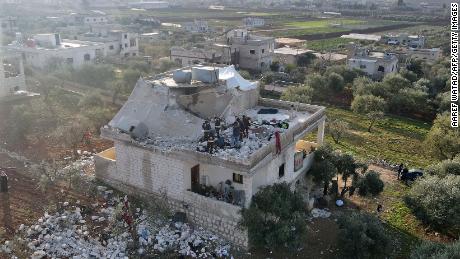The leader of ISIS died this week. But the terror group remains a formidable force, UN finds

The report — compiled by UN experts on ISIS and al Qaeda and covering the last six months of 2021 — says ISIS may still have up to $50 million in its coffers. It was completed before The UN analysis says that in Iraq, ISIS continued in the second half of 2021 “to launch attacks at a steady rate, including hit-and-run operations, ambushes and roadside bombs,” especially in a swathe of territory north of Baghdad. “Cells in Iraq also focus on economic warfare, targeting infrastructure, in particular power lines,” it adds.The UN monitors assess that ISIS is also rebuilding in the far west of Iraq, including “strongholds and tunnels with many sleeper cells and hundreds of fighters in the Anbar desert.”The report depicts a leadership living under deep cover. It says one government noted that Qurayshi — while thought to be somewhere in Syria — “takes extreme measures to ensure his security, allowing no electronics to be carried in his vicinity.” He was thought to be moving regularly between Syria and Iraq.Despite all his precautions, he was found in Idlib province, and now ISIS has a succession problem, for the second time in two years. Abu Bakr al-Baghdadi The UN report says the views of governments differ on the impact of this attrition. “Some member states assess that the group is significantly undermined by these losses, while others assess that the threat of a resurgence by the ISIL core remains.”The complex ISIS attack aimed at freeing prisoners in Hasakah in northern Syria last month may hint at that resurgence. Fitton-Brown says it was a significant development and some important prisoners were freed. Others were killed or recaptured, but, he adds, “they will consider the disruption and propaganda to have been worth that price, but it’s too early to say what it tells us about, or what impact it will have on — the group’s capabilities.”The UN report says that ISIS’ war chest is significantly less than when its self-declared caliphate ruled large parts of Syria and Iraq. However, it’s far from penurious. “Funds assessed as being available to ISIL in the core of the conflict zone are holding steady at between $25 million and $50 million, with much of it assessed to remain in Iraq,” the report states. However, governments believe the group is now consistently spending more than it takes in.Some of that cash is being funneled to Afghanistan, where the UN experts believe that the ISIS affiliate (ISIS-K) is recruiting and expanding. In recent months, the group has released regular videos of its attacks on Taliban officials and fighters, in both eastern Afghanistan and the capital. ISIS-K carried out the devastating The report says ISIS-K “has demonstrated a continuing ability to mount sophisticated attacks, adding to the complexity of the security situation in Afghanistan.” UN member states assess that the strength of ISIS-K has now risen from earlier estimates of 2,200 to approaching 4,000, following the release of several thousand prisoners. One member state assessed that up to half of ISIS-K is composed of foreign terrorist fighters. The UN team says that after six months of Taliban rule, “Afghanistan has the potential to become a safe haven for Al-Qaida and a number of terror groups with ties to the Central Asia region and beyond.” It notes that some of al Qaeda’s “closest sympathizers within the Taliban now occupy senior positions in the new de facto Afghan administration,” and confirms the return to Afghanistan of a former senior aide to the deceased al Qaeda leader Osama bin Laden.Central Asian terror groups such as Islamic Jihad Group and the Islamic Movement of Uzbekistan “are now experiencing greater freedom of movement in the country,” the report says. “Central Asian embassies based in Afghanistan have observed with concern that several leaders of those groups have travelled freely to Kabul.”In their section on jihadi activity in Africa, the UN monitors note that “Al-Qaida and ISIL affiliates in West Africa appear to have made decisive progress by exploiting local grievances, overwhelming stretched security forces and navigating complex interrelationships between armed groups.”The strength of the al Qaeda affiliate in Mali is such that “the capital city itself is under threat, with a security bubble now limited to a 40-kilometre circle around Bamako,” according to several governments.Looking further ahead, the report raises the specter of a new generation of terrorists emerging from the refugee camps of northern Syria. One of those camps, al-Hawl, contains some 60,000 people, and the UN report assesses it is under “ISIS’ social control.””Remaining stranded in harsh conditions, surrounded by radicalizing influences, may cause younger residents, especially, to become hardened and trained extremists,” says the UN report. “A generation of children, many raised in incubators of violent extremism, are at particular risk,” the UN experts conclude.





